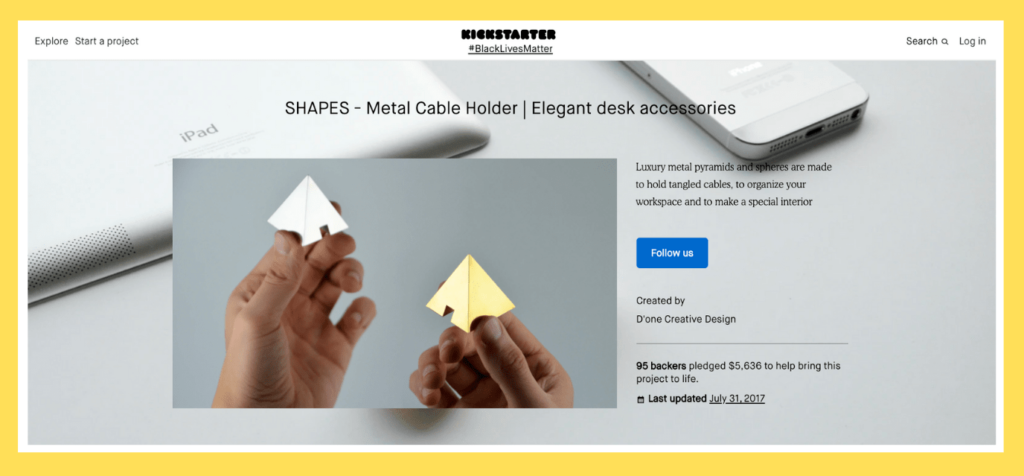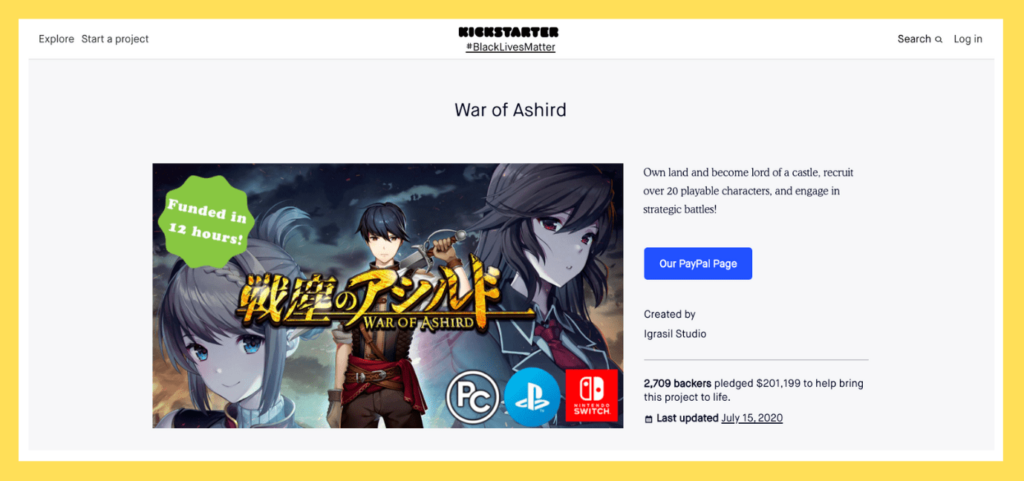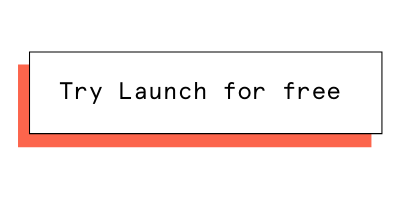Updated August 30, 2023
You’re getting ready to launch a crowdfunding campaign. You’ve got your prototype and you’re about to set up your crowdfunding campaign page. But have you taken time to build your email list? Whether you’re launching on BackerKit , Indiegogo, or Kickstarter, an email list isn’t just something that’s “nice to have” — it’s the foundation of your campaign. If you don’t have a strong email list, you’re going to have a hard time reaching your goal. To give your project the best chance of success, building an email list of people who have shown interest in your project or projects like yours is essential. Here’s why:
1. Email list size can be an indicator of crowdfunding success
Email conversion rates — that is, the number of people on an email list who end up pledging to a campaign — vary. However, in most cases only a small percentage — generally, we find around 1%to 5% — of the people on a high-quality email list will end up backing your project. A high-quality list is one in which subscribers knew what they were signing up for when they submitted their addresses and where addresses were collected through legitimate means. Legitimate list-building tactics include collecting email addresses through in-person events, online forum communities, and social media.
When you plan for your campaign knowing that a relatively low percentage of people on a legitimate email list will convert, you can get a good estimate of a couple of things:
- What would be a reasonable funding goal for your project
- How many email contacts you should be shooting for
- What the average price of your rewards should be
A note on email conversion rates
If you’re eyeing a $10,000 funding goal, and you have an average pledge of $100, you’ll need to get 100 backers to hit that goal. With a 5% conversion rate, you should have at least 2,000 people on your email list. So what if you were getting ready to launch, and you didn’t have that many people on your list? Does that mean you’re going to fail?
Well, not necessarily. First of all, it’s important to note that the number of people on your list is just one of the factors that contribute to your campaign’s success. Campaigns fail and succeed for a number of reasons, including not clearly communicating what the product is, not properly structuring reward tiers, and not effectively marketing the campaign once it’s live. Additionally, there are some cases where a smaller list may suffice. For instance, you may have a personal list of people who have pre-committed to backing or that you know are invested in the success of the project.
That 1% to 5% conversion rate isn’t prescriptive, but it is something to keep in mind. Taking it into account can help you focus your list-building activities and put you in a more comfortable position on launch day.
However, when you collect a specific number of email addresses that lines up with your funding goal, it puts you on the right track. So if you don’t have the list that you need, it would probably be best to postpone your campaign until you do.
Adjusting your funding goal
The creators of Shapes — a metal cable holder that keeps your workspace organized — first launched their project in 2016. They set a $3,000 funding goal. But when it didn’t look like they were going to hit their goal, they decided to cancel their project and re-launch.

The second time around, they set a goal of $1,000 which was based on the number of people they had in their audience. Interestingly, their new campaign actually ended up surpassing their goal, raising more than $5,000.
Like Shapes, War of Ashird, an RPG video game, had struggled when they initially launched the project. The creators didn’t have a strong audience coming into the project and were only able to raise around $51,000 of their $82,000 goal before they cancelled the project.

They took some time to revise their outreach strategy, lowered their funding goal to $31,500, and relaunched the project. Not only did they hit their new goal, but they were also funded in just 12 hours. When their campaign ended, they’d raised $201,199.
 Quick tip: Ideally, a crowdfunding creator would have a decent email list before they launch. But if you’re already in the middle of your campaign, and realize that you don’t have the support that you need to get funded this time around, there’s no shame in relaunching. Actually, a failed project can be an excellent learning experience for a first-time creator. Look at it as an opportunity to build a stronger community.
Quick tip: Ideally, a crowdfunding creator would have a decent email list before they launch. But if you’re already in the middle of your campaign, and realize that you don’t have the support that you need to get funded this time around, there’s no shame in relaunching. Actually, a failed project can be an excellent learning experience for a first-time creator. Look at it as an opportunity to build a stronger community.
2. You can’t count on people discovering your project organically
One misconception that a lot of first-time creators have is that they can just launch a project and potential backers will magically land on their campaign page. But the likelihood of people seeing your project without you doing any kind of promotion or community building is slim.
 Quick tip: Collect email addresses with a project landing page, using BackerKit Launch — an email marketing and analytics tool for crowdfunding creators. The page should describe your project and have a call to action requesting visitors submit their email addresses to get updates. Direct visitors to the page through platforms where your prospects live, like social media, YouTube, or online forums. Consider cross-promotion, in which a partner shares your landing page with their audience.
Quick tip: Collect email addresses with a project landing page, using BackerKit Launch — an email marketing and analytics tool for crowdfunding creators. The page should describe your project and have a call to action requesting visitors submit their email addresses to get updates. Direct visitors to the page through platforms where your prospects live, like social media, YouTube, or online forums. Consider cross-promotion, in which a partner shares your landing page with their audience.
Build early momentum with a strong email list
Regardless of the platform you’re launching on, the first 48 hours after you launch are critical, and set the momentum for your campaign. This is the time when the most people will back you. With a strong email list of people who are enthusiastic about your project, you can secure those important, early pledges. In the days leading up to launch day, you should be sending emails to your subscribers to get them excited about your project and ready to pledge right away. You should also make sure to explain how crowdfunding works for those members of your audience who’ve never pledged before. It’s important to create an email strategy and send out messages at strategic times before and during your campaign.
 Quick tip: Make sure to collect email addresses from people who are likely to pledge and even become advocates for your project. Tap into existing audiences. Who are the people you can count on to pledge early and have shown interest in the work that you do? Family, friends, co-workers, and social media followers should be the first place you look.
Quick tip: Make sure to collect email addresses from people who are likely to pledge and even become advocates for your project. Tap into existing audiences. Who are the people you can count on to pledge early and have shown interest in the work that you do? Family, friends, co-workers, and social media followers should be the first place you look.
3. Validate your idea with your email list

You may have what it takes to succeed, but wouldn’t it be nice to find out what people think about your idea as soon as possible? Before you even have a prototype you can — and should — validate your crowdfunding concept by building your email list.
Are people interested in what you’re offering?
The idea behind this is simple: if you’re planning a crowdfunding campaign, and having a hard time getting email sign-ups after sharing your concept with your target audience, you might not be ready to launch. Alternatively, if people like the idea, and are excited about it, they’ll be happy to sign up for your email list. In this way, you can gauge interest in your project and start validating your idea.
Of course, email sign-ups aren’t the only indicator of whether or not you have an idea worth pursuing. You should also be researching what competitors are doing, if any similar ideas already exist, and your target audience’s needs. But you must take a long, critical look at your concept if you’re really struggling to collect email addresses.
Get feedback from your subscribers
One added benefit of building your email list right away — even if that list is very small, at first — is that you can get feedback on your project from your subscribers. Send out surveys or updates on how the development process is going, and find out what your audience thinks. In doing this, you’ll get valuable insights about what they’re looking for or areas of your project that you might need to refine or rethink.
What’s more, this type of communication is an excellent way to get your growing audience invested in your campaign and your success. If they were able to offer their opinions as you developed your project, they’re going to be excited to see and back the final product.
 Quick tip: Once you have a list, use BackerKit Launch to test its strength. Using Launch, you’ll be able to see which of your email contacts have pledged to crowdfunding projects before, and are therefore more likely to back your project. After you’ve launched, visit BackerTracker to see if you’re trending to hit your funding goal. If it doesn’t look like you’ll hit your goal, you may want to consider canceling your campaign, and relaunching later.
Quick tip: Once you have a list, use BackerKit Launch to test its strength. Using Launch, you’ll be able to see which of your email contacts have pledged to crowdfunding projects before, and are therefore more likely to back your project. After you’ve launched, visit BackerTracker to see if you’re trending to hit your funding goal. If it doesn’t look like you’ll hit your goal, you may want to consider canceling your campaign, and relaunching later.
4. Your crowdfunding email list is the foundation of your marketing strategy

Are you thinking about using Facebook ads to get more backers and promote your campaign? Awesome! But you should know that ads aren’t a substitute for building your email list. If you launch your campaign, and midway through, it’s trending to fail, ads will not save your project.
If you’re interested in a performance marketing service like BackerKit Marketing, there are a number of factors that will make your project a good candidate for this. BackerKit Account Executive Robert Wickham says, “for people who are planning their campaign, an email list is relatively important. Not having one — or having too small of a list — disqualifies them.” Another factor that Wickham looks at once the project is live is how well the campaign is performing day-to-day, and whether the creator is able to maintain that momentum.
There are other qualitative and quantitative factors that determine whether or not ads will be a cost-effective solution for a creator (these are things that you should discuss with a representative for the performance marketing service you’re planning to use). But the bottom line is that you need the community and momentum that having a strong email list provides you with to even be a good fit for paid marketing.
 Quick tip: Looking for free ways to get more backers? Before you launch, spend some time joining Facebook groups and online communities related to your project. Engage with these people and try to build genuine relationships with them. If it makes sense and isn’t against the community rules, let them know about the project you’re working on. The new friends might be want to sign up for your email list and support your campaign.
Quick tip: Looking for free ways to get more backers? Before you launch, spend some time joining Facebook groups and online communities related to your project. Engage with these people and try to build genuine relationships with them. If it makes sense and isn’t against the community rules, let them know about the project you’re working on. The new friends might be want to sign up for your email list and support your campaign.
Takeaways
- Creators who don’t have a strong email list pre-launch struggle to get pledges.
- Around 1% to 5% of the subscribers on a high-quality email list will back your campaign. Make sure that you have enough people on your list to hit your funding goal.
- It’s important to get pledges within the first 48 hours of your launch. Sending messages to subscribers on your list pre-launch can help you secure those essential, early pledges.
- You can’t expect people to stumble across your project on your chosen crowdfunding platform — you have to take the time to grow your audience before you launch.
- If you can’t get subscribers, it might be a sign that you need to rethink your project.
- Ads aren’t a substitute for community-building.
Start building your email list today by signing up for BackerKit Launch.
Editor’s Note: This blog post was originally published in 2020. It has been updated and revamped for accuracy.
